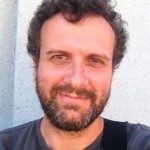Link to Pubmed [PMID] – 19751679
Biophys. J. 2009 Sep;97(6):1737-46
To investigate a putatively primordial protein we have simplified the sequence of a 56-residue alpha/beta fold (the immunoglobulin-binding domain of protein G) by replacing it with polyalanine, polythreonine, and diglycine segments at regions of the sequence that in the folded structure are alpha-helical, beta-strand, and turns, respectively. Remarkably, multiple folding and unfolding events are observed in a 15-micros molecular dynamics simulation at 330 K. The most stable state (populated at approximately 20%) of the simplified-sequence variant of protein G has the same alpha/beta topology as the wild-type but shows the characteristics of a molten globule, i.e., loose contacts among side chains and lack of a specific hydrophobic core. The unfolded state is heterogeneous and includes a variety of alpha/beta topologies but also fully alpha-helical and fully beta-sheet structures. Transitions within the denatured state are very fast, and the molten-globule state is reached in <1 micros by a framework mechanism of folding with multiple pathways. The native structure of the wild-type is more rigid than the molten-globule conformation of the simplified-sequence variant. The difference in structural stability and the very fast folding of the simplified protein suggest that evolution has enriched the primordial alphabet of amino acids mainly to optimize protein function by stabilization of a unique structure with specific tertiary interactions.

